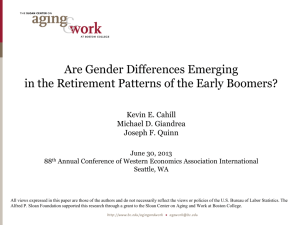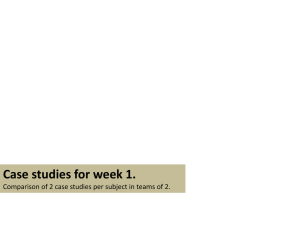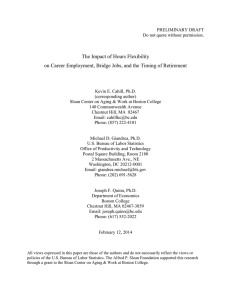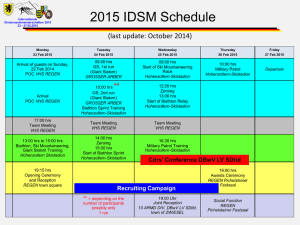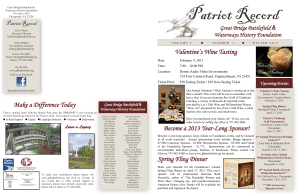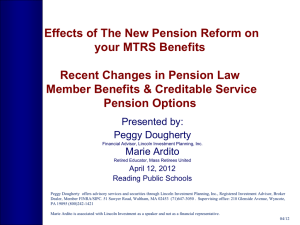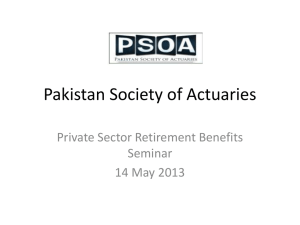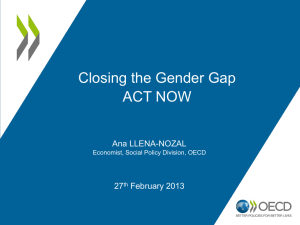View the slides of Cahill`s presentation
advertisement
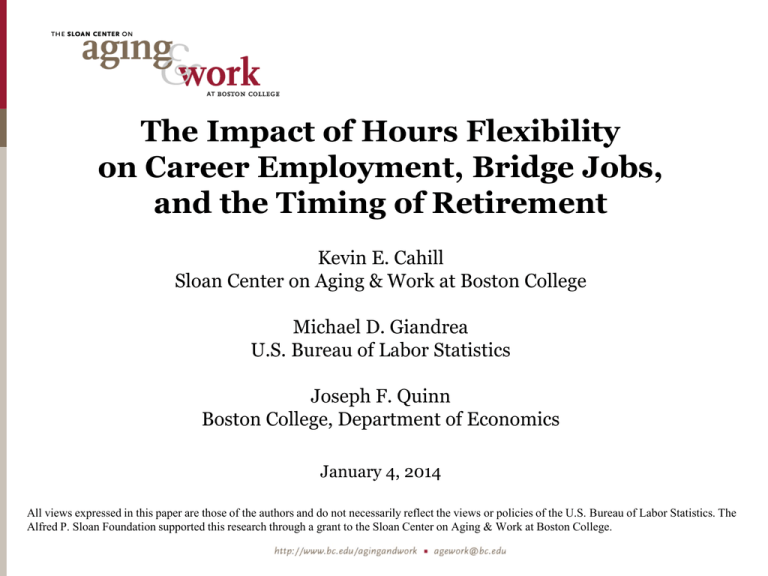
The Impact of Hours Flexibility on Career Employment, Bridge Jobs, and the Timing of Retirement Kevin E. Cahill Sloan Center on Aging & Work at Boston College Michael D. Giandrea U.S. Bureau of Labor Statistics Joseph F. Quinn Boston College, Department of Economics January 4, 2014 All views expressed in this paper are those of the authors and do not necessarily reflect the views or policies of the U.S. Bureau of Labor Statistics. The Alfred P. Sloan Foundation supported this research through a grant to the Sloan Center on Aging & Work at Boston College. Agenda Overview Data and Methods Prevalence of hours flexibility in career employment Relationship between hours flexibility and job transitions Relationship between hours flexibility and continued employment Conclusions and limitations Phased Retirement and the Retirement Process An illustration of the retirement process Our Paper Research Question To what extent does hours flexibility in career employment impact the retirement process? Motivation Can hours flexibility in career employment – phased retirement – extend work lives? Hours flexibility could extend career employment at the expense of curtailing bridge job employment. Or hours flexibility could extend both career employment and bridge employment. Key Findings Bridge job prevalence is higher among those with access to hours flexibility in career employment compared to those without. Hours flexibility in career employment is associated with longer tenure on bridge jobs (not necessarily causal, however). Background Older workers in the U.S. by and large express interest in hours flexibility (AARP, 2013; Center on Aging & Work, 2013) Employers face barriers to phased retirement (Johnson, 2011) Limitations on in-service distributions Defined-contribution (DC) plans: cannot take payments before leaving employer unless age 59 ½ or older Defined-benefit (DB) plans: cannot take payments before leaving employer unless age 62 or older => phased retirement is more or less ruled out before age 59 ½ for those with DC plans and age 62 for those with DB plans Anti-discrimination rules Tax-qualified benefits are required to be distributed equally across the employer’s workforce. Anti-discrimination rules come into play to the extent that phased retirement is preferred by higher compensated employees. Schedule coordination difficulties could exist as well Background (continued) Employee interest in and employer resistance to hours flexibility – combined with a flexible labor market – explains in part why bridge job prevalence (far) exceeds that of phased retirement in the U.S. What if more older Americans had access to phased retirement on the career job? Data and Methods The Health and Retirement Study A nationally-representative longitudinal dataset of older Americans that began in 1992 Ongoing with new cohorts and biennial follow-up interviews Cohorts relevant to our study HRS Core (51 to 61 in 1992) War Babies (51 to 56 in 1998) Early Boomers (51 to 56 in 2004) Methodology Define Full-Time Career (FTC) job = 1,600+ hours/year AND 10+ years of tenure Select respondents who were on a wage-and-salary FTC job at the time of their first interview Examine respondents’ work histories from 1992 to 2010 Availability and Use of Hours Flexibility in Career Employment HRS Respondents with a Wage-and-Salary Full-Time Career Job at the Time of the First Interviewa Bridge Job Prevalence by Gender and Hours Flexibility Status Percent HRS Core Respondents with a Wage-and-Salary Full-Time Career Job at the Time of the First Interview Note: Bridge job prevalence percentages do not include individuals who were out of work for two or more waves following career employment and later reentered. Percentages also do not include individuals who were self employed on their career job. Part-Time Status of Bridge Jobs by Gender and Hours Flexibility Status Percentage working part-time in bridge employment HRS Core Respondents with a Wage-and-Salary Full-Time Career Job at the Time of the First Interview Brief Summary Compared to those with hours flexibility in career employment, individuals without hours flexibility are: more likely to exit the labor force directly from career employment; and more likely to continue working full time if they do transition to a bridge job. Results could mean different things A true causal effect The lack of hours flexibility in career employment leads to direct exits and more abrupt transitions out of the labor force (e.g., “burn out”). A selection effect Individuals who plan on an abrupt exit from the labor force self-select into employers that do not offer hours flexibility. No true net effect on hours worked at all Those who reduce hours in career employment may be more likely to work in bridge jobs simply because they need to continue working later in life to make up for lost hours in career employment. Tenure in Career and Bridge Employment by Gender, HRS Cohort, and Hours Flexibility Status HRS Core Respondents with a Wage-and-Salary Full-Time Career Job at the Time of the First Interviewa Correlates of Tenure in Career Employment HRS Core Respondents with a Wage-and-Salary Full-Time Career Job at the Time of the First Interview *: Excluding HRS Core men. Correlates of Tenure in Bridge Employment HRS Core Respondents with a Wage-and-Salary Full-Time Career Job at the Time of the First Interview Multivariate Analysis of Years in Career and Bridge Employment, by Gender HRS Core Respondents with a Wage-and-Salary Full-Time Career Job at the Time of the First Interview Men Women Conclusions The low prevalence of phased retirement in the US – and the high prevalence of bridge employment – is in part the product of employees’ preferences for hours flexibility, employers’ (justifiable) resistance to offering such arrangements, and a flexible labor market. In our sample of older Americans with wage-and-salary career jobs, approximately one quarter could reduce the number of hours of paid work. Those without hours flexibility are the least likely to transition to bridge employment (but bridge job prevalence among this group is still notably high (45%+)). Hours flexibility is associated with longer tenures in career employment – with the notable exception of the male HRS Core respondents – and with longer tenures in bridge employment. Conclusions (continued) A continuation of sluggish growth and elevated unemployment rates (=> increased difficulty finding bridge employment) and a relaxing of regulatory barriers to phased retirement could shift the relative importance of bridge jobs and phased retirement in the years ahead. Preliminary evidence suggests that such a shift could further promote gradual exits from the labor force. Limitations The results are associations; self selection could be a critical driver of the results. Macroeconomic conditions will likely impact the extent to which these findings apply to the Early Boomers and future cohorts of older Americans. Appendix Bridge Job Prevalence by Gender and Hours Flexibility Status Percent HRS War Baby Respondents with a Wage-and-Salary Full-Time Career Job at the Time of the First Interview Note: Bridge job prevalence percentages do not include individuals who were out of work for two or more waves following career employment and later reentered. Percentages also do not include individuals who were self employed on their career job. The Macroeconomic Environment Faced by Different Cohorts of Older Americans The Dow Jones Industrial Average, 1992 – 2012 and Three Cohorts of HRS Respondents, Denoted by Their First Six Years of Survey Participation The Macroeconomic Environment Faced by Different Cohorts of Older Americans Unemployment Rate of the Population 55 Years and Over, 1992 – 2012 and Three Cohorts of HRS Respondents, Denoted by Their First Six Years of Survey Participation
